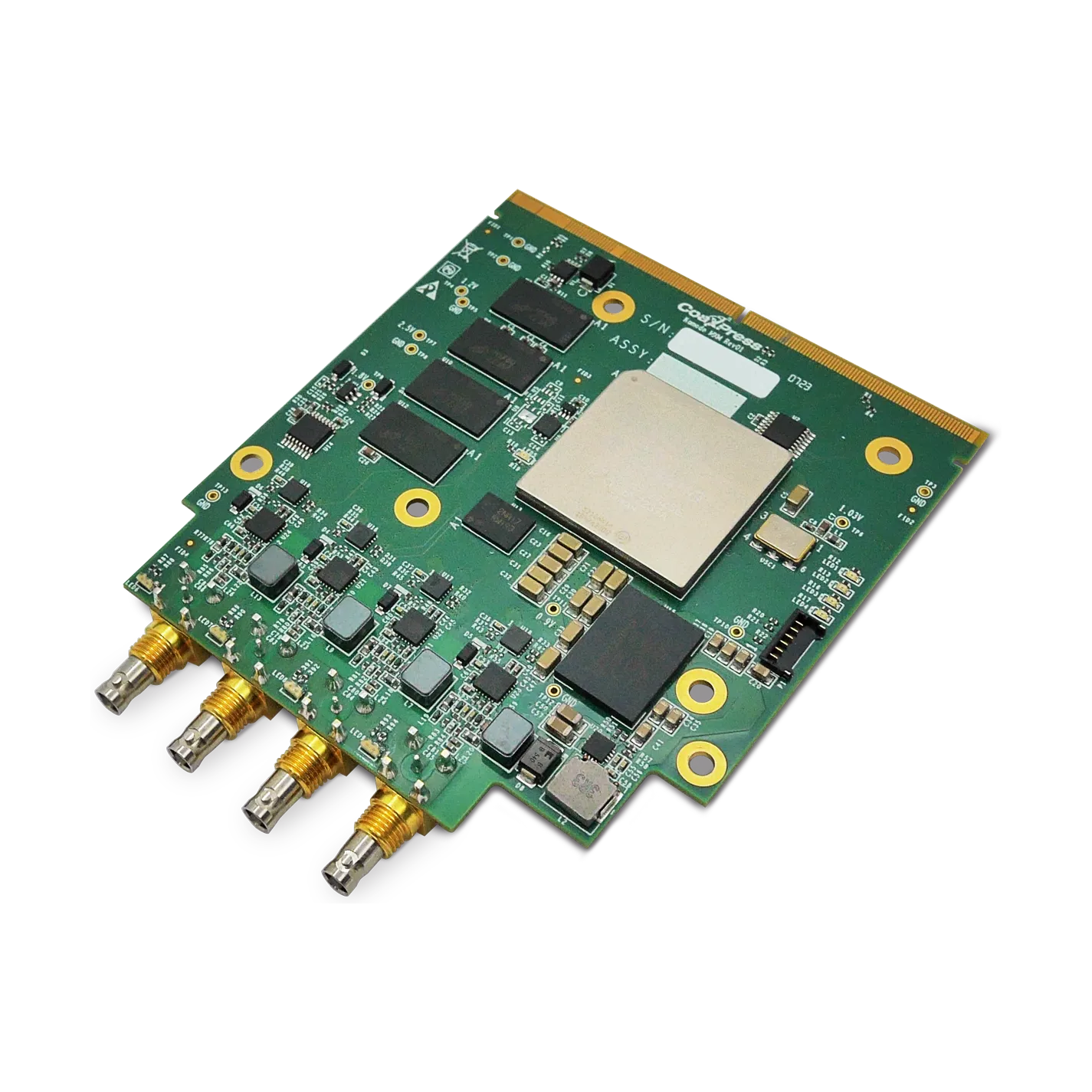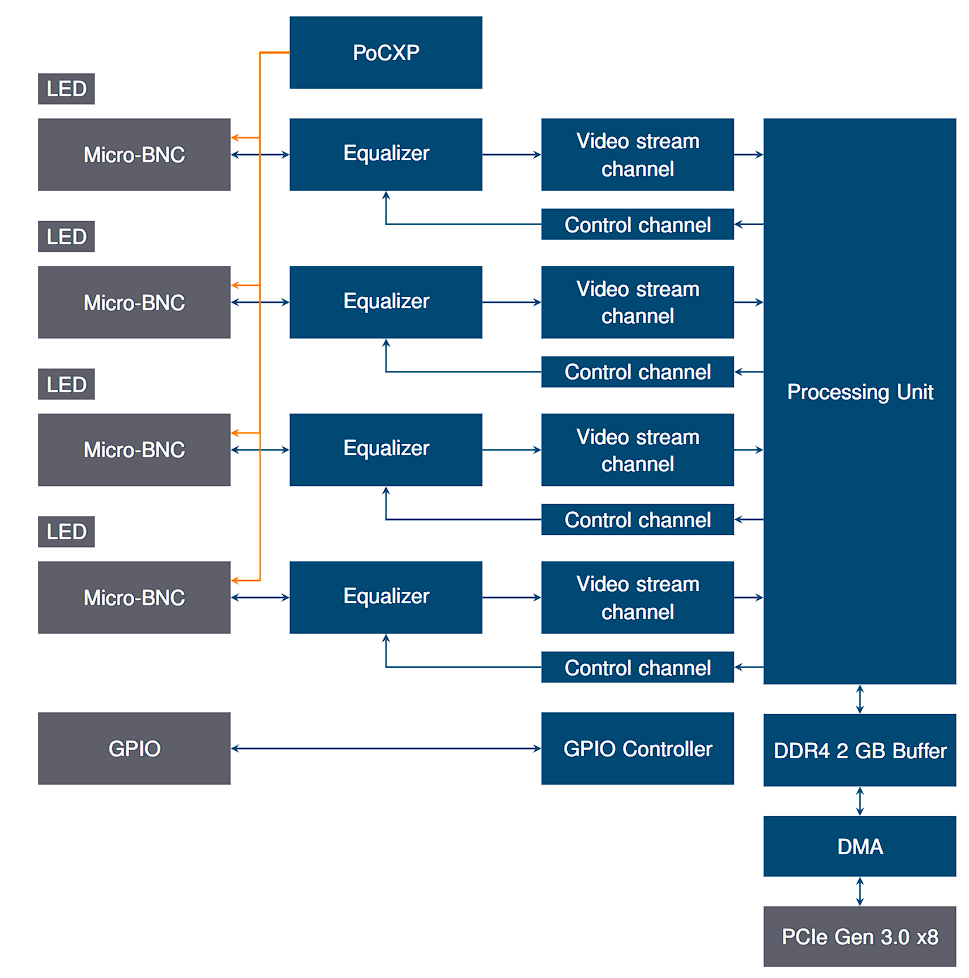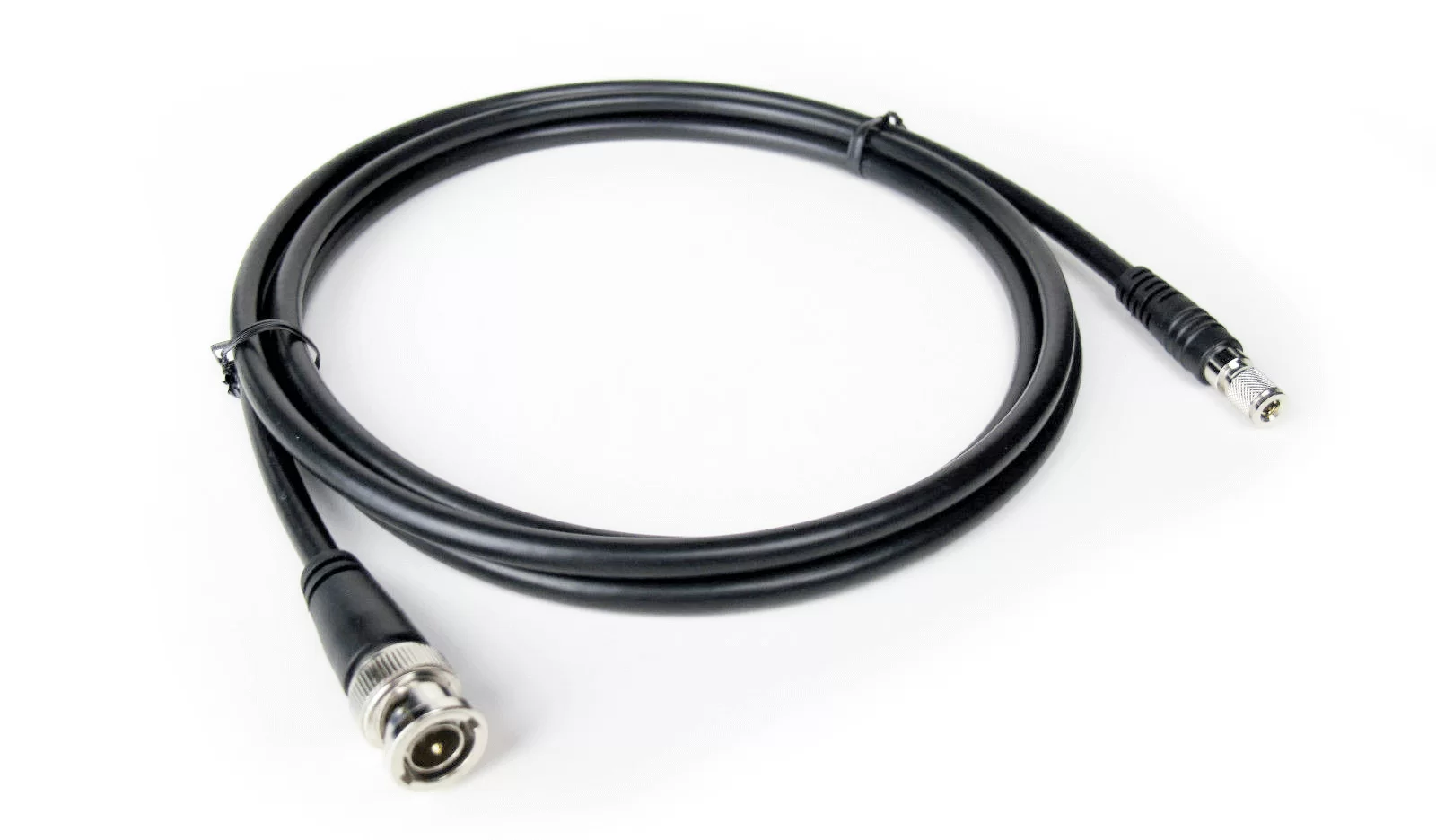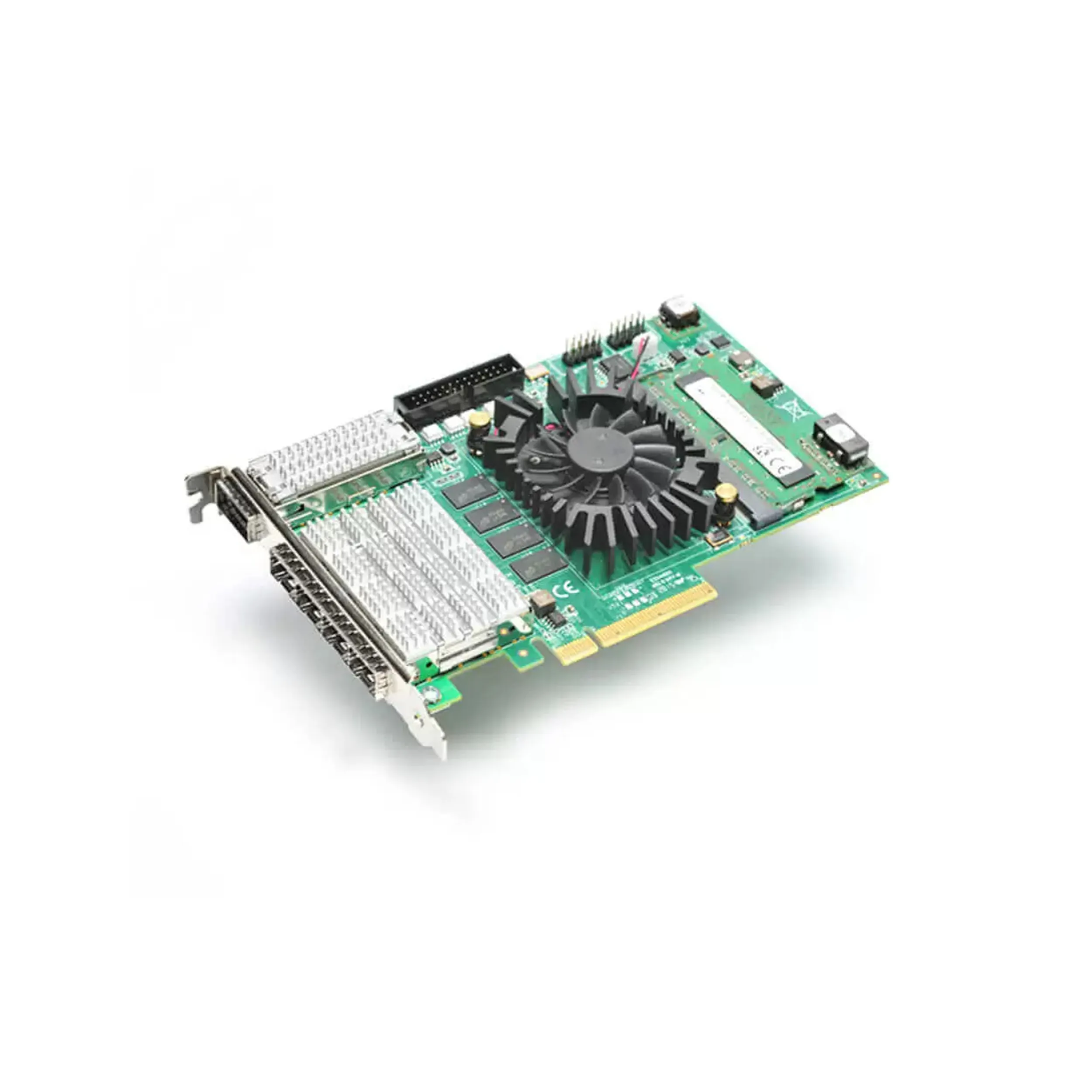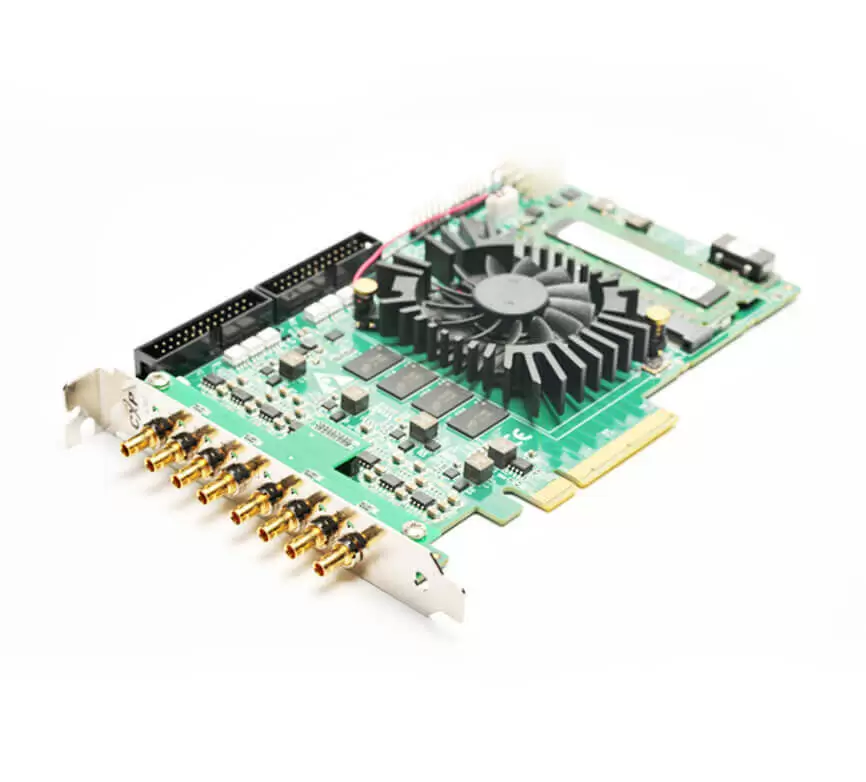| Form factor |
MXM card |
| Format |
8-lane MXM card |
| Cooling method |
Conduction cooling |
| Mounting |
MXM 2 mounting holes |
| Connectors |
Ports 1 through 4 via x4 Micro-BNC connectors for CoaXPress v2.1 interface |
|
x1 MXM edge connector (PCIe and GPIO) |
| Dimensions |
103.78 mm x 82 mm (4.1” x 3.2”) |
| Weight |
56 g (2.4 oz) |
| Standard |
PCI Express 3.0 |
| Link width |
8 lanes, 1, 2 or 4 lanes with reduced performance |
| Link speed |
8.0 GT/s (PCIe 3.0) |
|
5.0 GT/s (PCIe 2.0) with reduced performance |
| Maximum payload size |
2,048 bytes |
| DMA |
32- and 64-bit |
|
Scatter gather support |
|
Physical address support (GPU transfers) |
| Peak delivery bandwidth |
7,877 MB/s |
| Effective (sustained) delivery bandwidth |
6,695 MB/s (Host PC dependent) |
| Power consumption |
15 W, excluding camera and I/O power output |
| Interface standard(s) |
CoaXPress v2.1 (CoaXPress 1.0, 1.1, 1.1.1 and 2.0 backward
compatible) |
| Status LEDs |
1 bicolor status LED per connector |
|
4 System status LEDs |
| Number of cameras |
Up to 4 |
| Number of links per Single camera |
Up to 4 |
| Synchronization between cameras |
Yes |
| Line-scan cameras supported |
Yes |
| MAX aggregated camera data transfer rate |
50 Gbit/s |
| Supported CXP down-connection speeds |
1.25 GT/s (CXP-1) |
|
2.5 GT/s (CXP-2) |
|
3.125 GT/s (CXP-3) |
|
5 GT/s (CXP-5) |
|
6.25 GT/s (CXP-6) |
|
10 GT/s (CXP-10) |
|
12.5 GT/s (CXP-12) |
| Number of data streams (per camera) |
1 data stream per camera |
| Maximum stream packet size |
8.192 bytes |
| PoCXP (power over CoaXPress) |
PoCXP Safe Power |
|
13 W of 24V DC regulated power per CoaXPress connector |
|
PoCXP Device detection and automatic power-on |
|
Overload and short-circuit protections |
|
Optional On-board 12V to 24V DC/DC converter |
| Camera types |
Area-scan cameras: |
|
Gray-scale and color (RGB and Bayer CFA) |
|
Single-tap (1X-1Y) progressive-scan |
|
Line-scan cameras: |
|
Gray-scale and color RGB |
| Camera pixel formats supported |
Raw, Monochrome, Bayer, RGB, YUV, YCbCr and RGBA (PFNC names): |
|
Raw |
|
Mono8, Mono10, Mono12, Mono14, Mono16 |
|
BayerXX8, BayerXX10, BayerXX12, BayerXX14, BayerXX16 where XX = GR, RG, GB, |
|
or BG |
|
RGB8, RGB10, RGB12, RGB14, RGB16 |
|
RGBA8, RGBA10, RGBA12, RGBA14, RGBA16 |
|
YUV411_8, YUV411_10, YUV411_12, YUV411_14, YUV411_16 |
|
YUV422_8, YUV422_10, YUV422_12, YUV422_14, YUV422_16 |
|
YUV444_8, YUV444_10, YUV444_12, YUV444_14, YUV444_16 |
|
YCbCr601_411_8, YCbCr601_411_10, YCbCr601_411_12, YCbCr601_411_14, |
|
YCbCr601_411_16 |
|
YCbCr601_422_8, YCbCr601_422_10, YCbCr601_422_12, YCbCr601_422_14, |
|
YCbCr601_422_16 |
|
YCbCr601_444_8, YCbCr601_444_10, YCbCr601_444_12, YCbCr601_444_14, |
|
YCbCr601_444_16 |
| Trigger |
Precise control of asynchronous reset cameras, with exposure control. |
|
Support of camera exposure/readout overlap. |
|
Support of triggering from encoder or timer. |
|
Support of external hardware trigger, with optional delay, filtering and trigger decimation. |
| Strobe |
Accurate control of the strobe position for strobe light sources. Support of early and late |
|
strobe pulses. |
| Scan/page trigger |
Precise control of start-of-scan and end-of-scan triggers. |
|
Support of external hardware trigger, with optional delay and filtering. |
|
Support of triggering from encoder. |
|
Support of infinite acquisition without missing lines. |
| Line trigger |
Support for quadrature motion encoders, with programmable filters, selection of acquisition |
|
direction and backward motion compensation. |
| Line strobe |
Accurate control of the strobe position for strobe light sources. |
| On-board memory |
2GB DDR4 |
| Bayer De-Mosaic |
Full 16bit resolution |
|
Bilinear 3×3 |
|
Bilinear 3×2 for linescan with gradient correction |
| Color transformation |
Full 16bit resolution 18bit coefficients table: |
|
Color space conversion |
|
Gain and Offset |
| Decimation |
Line skip |
| Additional features |
Unpacking of 10-/12-/14-bit to 16-bit with justification to LSB |
| Frame timestamp |
64bit with 8ns precision |
| Data stream statistics |
Measurement of: |
|
Frame/Line rate |
|
CRC Errors |
|
Dropped frames |
|
Received packets |
|
Test packets |
| Event signaling and counting |
The application software can be notified of the occurrence of various events: |
|
Newly acquired buffers |
|
Camera and Illumination control events |
|
I/O events |
|
Timer events |
|
Encoder events |
| Number of lines |
12 I/O lines: |
|
2 differential inputs |
|
2 differential outputs |
|
4 singled-ended TTL inputs/outputs |
|
4 singled-ended LVTTL inputs/outputs |
| Usage |
Any System I/O input lines can be connected to any I/O line |
|
Any I/O line can be used to decode A/B and Z signals of a motion encoder |
|
Any I/O line can generate any trigger event |
|
Any I/O line can trigger a timer |
| Electrical specifications |
Differential lines – LVDS compatible |
|
TTL lines: 5V TTL compliant |
|
LVTTL lines: 3.3V LVTTL compliant |
| Filter control |
Glitch removal filter available on all System I/O input lines |
|
Configurable filter time constants: |
|
for DIN and TTLIO lines: 50 ns, 100 ns, 200 ns, 500 ns,1 µs |
|
for IN lines: 500 ns, 1 µs, 2 µs, 5 µs, 10 µs |
| Polarity control |
Yes |
| Encoders |
4 quadrature encoders with A/B and Z inputs |
|
32bit position counter |
|
Forward and backward counting |
|
Position trigger support |
|
Noise filtering |
| Timers |
4 general purpose timers |
|
Configurable delay and duration |
|
32bit accumulator |
| Event reporting |
64-bit system timestamp event reporting |
|
Each I/O line can generate event on configurable edge |
|
Each Timer can generate event |
|
Each encoder can generate event |
| Synchronization |
Precise area and line-scan cameras synchronization across different frame grabbers |
| Host PC operating system |
Microsoft Windows 10 64-bit version |
|
Open source Linux kernel driver |
|
Tested and precompiled for Ubuntu 18.04 and 20.04 versions |
|
Nvidia Xavier AGX |
| GenCam |
Support of Gen<i>Cam 3.2 |
|
Full camera and Frame Grabber parameters configuration |
| Buffer management |
Circular buffer support |
|
Accumulation of several frames/lines to single buffer to reduce CPU load |
|
CPU load |
|
DMA Buffer filling directly to system memory |
| GUI |
Supported for Windows and Linux OS |
|
Multi camera display and configuration |
|
Flexible buffer queuing |
|
Image/video recording and playback |
| Debugging capabilities |
Event logging |
|
Statistics counters |
| APIs |
Gen<i>Cam, GenTL producer libraries, C/C++, Python and NET bindings |
|
Compilers: |
|
x86_64 dynamic library designed to be used with ISO-compliant C runtime |
|
Allows for development of x86_64 applications |
|
Plug-in modules for Matlab, HALCON, Cognex and Labview |
| Operating ambient air temperature |
-40°C to +85°C / -40°F to +185 °F |
| Operating ambient air humidity |
10% to 90% RH non-condensing |
| Storage ambient air temperature |
-60°C to +90°C / -76°F to +194°F |
| Storage ambient air humidity |
10% to 90% RH non-condensing |
| Shock/Vibration |
MIL-STD-810G |
| Electromagnetic – EMC standards |
The European Council EMC Directive 2004/108/EC |
|
The Unites States FCC rule 47 CFR 15 |
| EMC – Emission |
EN 55022:2010 Class B |
|
FCC 47 Part 15 Class B |
| EMC – Immunity |
EN 55024:2010 Class B |
|
EN 61000-4-3 |
|
EN 61000-4-4 |
|
EN 61000-4-6 |
| Flammability |
PCB compliant with UL 94 V-0 |
| RoHS |
Compliant with the European Union Directive 2011/65/EU (RoHS2) |
| REACH |
Compliant with the European Union Regulation No 1907/2006 |
| WEEE |
Must be disposed of separately from normal household waste and must be recycled |
|
according to local regulations |
| Ordering Information |
KY-FGK-II-MXM |
| Optional accessories |
CoaXPress cables |
